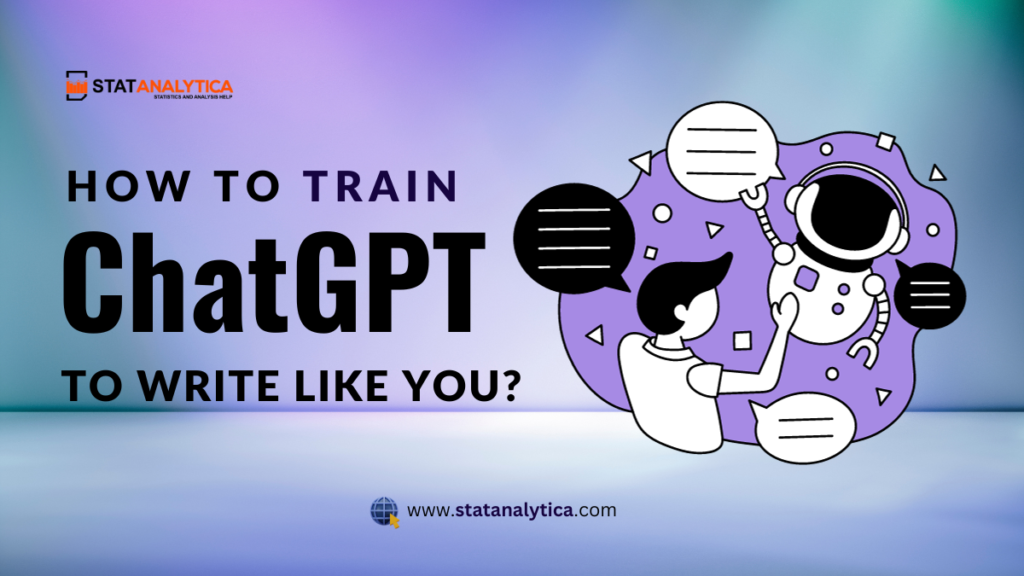Welcome to the exciting world of how to train chatgpt to write like you! Have you ever wondered how to shape AI’s language skills to match your own? As it has made the work much easier and time saving for everyone it is necessary to do so. This guide is your gateway to that journey. Learning to train ChatGPT is like teaching a super-smart buddy to speak your language, think your thoughts, and express your style!
Whether you’re a beginner or just curious, we’ll explore step-by-step techniques that’ll make ChatGPT echo your unique voice. No complex jargon here, just simple, easy steps to mold this AI to mirror your writing style. Let’s dive in and unleash the power to make ChatGPT sound just like you do.
| Unlock the power of data with our expert guidance! Ace your Data Science Assignments effortlessly, backed by our skilled team’s support and knowledge. |
ChatGPT in US Offices
Table of Contents
Thirty-five percent of US workers claim that the use of AI tools has impacted their job duties. Following our inquiry with 1,000 respondents regarding the tasks and industries in which they find ChatGPT most helpful, we got the following answers:

- It should come as no surprise that the most popular use of ChatGPT is writing content similar to human content.
- Customer service and data analysis are two other areas where ChatGPT appears to be widely used.
- It’s interesting to note that workers appear to depend on the application even for more creative use cases, such as “navigating tough conversations” and “brainstorming and developing new ideas.”
- According to the report, 20% of US workers have never used ChatGPT, and 30% have never used it for work-related reasons.
- Not surprisingly, Gen Z and millennials appear to use ChatGPT more frequently. Just 24% of workers between the ages of 18 and 44 have not used ChatGPT for work-related reasons, and 16% have not used it at all.
- However, when we look at employees aged over 45 years, 43% have never used ChatGPT for business and 29% have never used it at all.
How To Train Chatgpt To Write Like You?
Teaching an AI to mirror your writing style might seem tricky, but with the right steps, it’s possible to guide it to speak in your unique voice. Let’s explore how you can train ChatGPT to write as if it were you. There are three ways to do so and they are as:
- Training with the help of personal samples
Training ChatGPT to adopt your personal writing style is an exciting journey toward making an AI speak in your own words. By providing it with samples of your writing, you can shape its language and tone to resemble your unique style. The process involves a few key steps that allow ChatGPT to learn and reflect your writing nuances. Here’s a guide outlining the steps to train ChatGPT using your personal writing as a reference. Let’s start.

- Prepare Your Writing Sample
Select a sample of your writing that showcases your style—whether it’s a story, an article, or a conversation. Ensure it represents the tone, vocabulary, and structure you want the AI to learn.
- Tokenization and Preprocessing
Break down your writing sample into smaller units, such as words or sub-phrases, known as tokens. This step helps the AI process and understand the text more effectively.
- Fine-Tuning Process
Use the writing sample as a basis for fine-tuning the AI. Incorporate the sample into the AI training process by providing it as part of the training dataset.
- Interactive Training
Engage in conversations with ChatGPT while providing prompts and responses that align with your writing style. Continuously refer back to your writing sample to reinforce the desired style.
- Feedback Loop
Encourage the AI when it responds in a way that resembles your writing. Correct or guide it gently when it deviates, reinforcing the specific elements of your style.
- Iterative Process
Repeat the training process multiple times, incorporating your writing sample and adjusting the AI’s responses based on the desired style. This helps the AI refine its understanding of your style over time.
- Custom Instructions
The custom instructions option in ChatGPT allows users to give specific guidelines or directions to the AI model about how they want their conversation or interaction to proceed. Here’s a breakdown in simple language:

- Guiding ChatGPT: This option lets you tell the AI how to respond to you.
- Specific Directions: You can give clear instructions or rules to ChatGPT.
- Tailored Conversation: It helps ChatGPT understand what you want and how you want the conversation to go.
- Examples: You might ask it to talk about a certain topic, use a particular tone, or provide information in a specific style.
- Improved Interaction: By using custom instructions, you guide the AI to better meet your needs and preferences during the conversation.
- AIPRM Extension
AIPRM (AI-Powered Risk Management) extensions aren’t typically directly related to personalized writing. However, AI and machine learning, which are often integral to AIPRM systems, can be applied in various ways to enhance personalized writing experiences.

- Content Generation
AI-driven tools can examine huge data to interpret user preferences and create personalized content. For instance, they can suggest personalized recommendations for blog topics, emails, or marketing content based on user behavior and interests.
- Language Assistance
AI-powered writing assistants like Grammarly or ProWritingAid utilize machine learning to offer personalized suggestions for improving writing. They learn from user interactions and provide tailored feedback to enhance clarity, grammar, and style, making writing more personalized and effective.
- Customized Messaging
In marketing, AI-powered systems analyze customer data to create personalized messages for specific audiences. These systems can craft customized emails, advertisements, or social media content based on individual preferences and behaviors.
- Adaptive Communication
Chatbots and virtual assistants use AI algorithms to personalize conversations with users. They learn from interactions and adapt their responses to suit individual preferences, improving the overall user experience.
- Content Curation
AI algorithms analyze user behavior, such as browsing history or content engagement, to curate personalized recommendations. Platforms like Netflix or Spotify use this technology to suggest movies, shows, or music tailored to individual tastes.
While AIPRM might not directly focus on personalized writing, the underlying AI and ML technologies it employs are part of a broader ecosystem that enhances personalization across various aspects of content creation, communication, and user interaction. These tools leverage data-driven insights to cater to individual needs and preferences in writing and communication.
What Are The Reasons Behind Chatgpt’s Popularity?
ChatGPT has gained immense popularity for several reasons, making it a beloved AI among users worldwide. Here are some key reasons:

- Natural Conversational Abilities
ChatGPT can engage in natural, human-like conversations, responding to queries and holding meaningful discussions. Its feature to understand context and provide relevant responses makes it appealing.
- Vast Knowledge Base
It draws information from an extensive dataset, allowing it to provide diverse and accurate answers on a huge number of topics, from history to science and beyond.
- User-Friendly Interface
ChatGPT’s user interface is simple and easy to interact with, making it accessible to people with varying technical skills. Users appreciate its straightforwardness.
- Adaptability and Learning
It adapts and learns from interactions, improving its responses over time. This adaptability enhances its usefulness in various contexts, catering to specific user needs.
- Versatility in Applications
Its versatility allows it to be applied across different domains, from customer service to creative writing, educational purposes, and more, making it a valuable tool in various fields.
- Constant Improvement
Continuous updates and improvements by its developers contribute to its evolving capabilities, ensuring it stays up-to-date and relevant.
ChatGPT’s popularity stems from its ability to mimic human-like conversation, its vast knowledge, ease of use, adaptability, versatility in applications, and continuous enhancements that keep it at the forefront of AI technology.
Conclusion
In conclusion, after seeing how to train ChatGPT to write like you is a simple process that involves gathering your most you-like content, asking ChatGPT to analyze your writing, and repeating the process. ChatGPT’s popularity can be attributed to its user-friendly interface, availability, confidentiality, versatility, accuracy, and flexibility. ChatGPT currently has over 180 million users, and the website sees nearly 1.5 billion visitors per month. The AI model is trained using GPT-3.5, whereas the Plus users can access GPT-4 from March 2023. ChatGPT’s rise in popularity can be attributed to its novelty factor, flexibility, and usefulness in helping with a wide range of tasks. The sensational rise of ChatGPT reveals both its usefulness and potential for the future.


